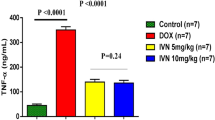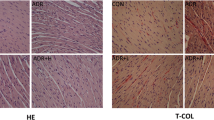Abstract
Adriamycin is one of the most effective and useful antineoplastic agents. Acute doxorubicin cardiotoxicity involved cardiomyocyte apoptosis. In this study, we investigated whether adriamycin induced myocardium apoptosis through activation of nuclear factor κB in rat. Forty male Wistar rats were randomly divided into five groups: control, ADR 5 mg/kg, ADR 10 mg/kg, ADR 15 mg/kg group and ADR + PDTC 200 mg/ml group. Myocardial apoptosis was detected by DNA fragmentation assay and TUNEL assay; Location and distribution of p-IκBα was observed by immunohistochemical assay; Myocardial expression of p-IκBα protein was assessed by Western blot analysis; Activity of NF-κB was evaluated by Electrophoretic Mobility Shift Assay. The myocardial apoptotic index, expression of p-IκBα, and binding activity of NF-κB increased significantly in ADR groups in dose-dependent manner. PDTC as a nonspecific inhibitor of NF-κB protected myocardium from apoptosis by inhibiting NF-κB activation. Adriamycin induces myocardium apoptosis through activation of nuclear factor κB in rat and NF-κB activation requires IκBα degradation.





Similar content being viewed by others
References
Morabito A, Gattuso D, Stani SC (2004) Safety and activity of the combination of pegylated liposomal Doxorubicin and weekly docetaxel in advanced breast cancer. Breast Cancer Res Treat 86:249–257
Novitzky N, Thomas V, Abrahams L, Toit C, Donald M (2004) Increasing dose intensity of anthracycline antibiotics improves outcome in patients with acute myelogenous leukemia. Am J Hematol 76:319–329
Hequet O, Le QH, Moullet I (2004) Subclinical late cardiomyopathy after doxorubicin therapy for lymphoma in adults. J Clin Oncol 22:1864–1871
Lipshultz SE, Rifai N, Dalton VM (2004) The effect of dexrazoxane on myocardial injury in doxorubicin-treated children with acute lymphoblastic leukemia. N Engl J Med 351:145–153
Olli JA, Antti S, Kari P, Markku K, Martti P, Liisa-Maria V-P (2000) Acute doxorubicin cardiotoxicity involves cardiomyocyte apoptosis. Cancer Res 60:1789–1792
Nakamura T, Ueda Y, Juan Y, Katsuda S, Takahashi H, Koh E (2000) Fas-mediated apoptosis in adriamycin-induced cardiomyopathy in rats: in vivo study. Circulation 102:572–578
Lou H, Danelisen I, Singal PK (2005) Involvement of mitogen-activated protein kinases in adriamycin-induced cardiomyopathy. Am J Physiol Heart Circ Physiol 288:H1925–H1930
Muller DN, Dechend R, Mervaala E (2000) NF-κB inhibition ameliorates angiotensin II-induced inflammatory damage in rats. Hypertension 35:193–201
Beswick RA, Zhang H, Marable D, Catravas JD, Hill WD, Webb RC (2001) Long-term antioxidant administration attenuates mineralocorticoid hypertension and renal inflammatory response. Hypertension 37:781–786
Kim SB, Kim JS, Lee JH, Yoon WJ, Lee DS, Ko MS, Kwon BS, Choi DH, Cho HR, Lee BJ, Chung DK, Lee HW, Park JW (2006) NF-κB activation is required for cisplatin-induced apoptosis in head and neck squamous carcinoma cells. FEBS Lett 580:311–318
Chong ZZ, Li F, Maiese K (2005) Erythropoietin requires NF-κB and its nuclear translocation to prevent early and late apoptotic neuronal injury during beta-amyloid toxicity. Curr Neurovasc Res 2:387–399
Zhou S, Palmeira CM, Wallace KB (2001) Doxorubicin-induced persistent oxidative stress to cardiac myocytes. Toxicol Lett 121:151–157
Koutinos G, Stathopoulos GP, Dontas I (2002) The effect of doxorubicin and its analogue mitoxantrone on cardiac muscle and on serum lipids: an experimental study. Anticancer Res 22:815–820
Mukherjee S, Banerjee SK, Maulik M, Dinda AK, Talwar KK, Maulik SK (2003) Protection against acute adriamycin-induced cardiotoxicity by garlic: role of endogenous antioxidants and inhibition of TNF-α expression. BMC Pharmacol 3:16
Mohamed HE, Asker ME, Ali SI, Fattah TM (2004) Protection against doxorubicin cardiomyopathy in rats: role of phosphodiesterase inhibitors type 4. Pharm Pharmacol 56:757–768
Dudnakova TV, Lakomkin VL, Tsyplenkova VG, Shekhonin BV, Shirinsky VP, Kapelko VI (2003). Alterations in myocardial cytoskeletal and regulatory protein expression following a single Doxorubicin injection. J Cardiovasc Pharmacol 41:788–794
RVitelli M, Filippelli A, Rinaldi B (2002) Effects of docosahexaenoic acid on [Ca(2+)](i) increase induced by doxorubicin in ventricular rat cardiomyocytes. Life Sci 71:1905–1916
Zhou S, Heller LJ, Wallace KB (2001) Interference with calcium-dependent mitochondrial bioenergetics in cardiac myocytes isolated from doxorubicin-treated rats. Toxicol Appl Pharmacol 175:60–67
Wu S, Ko YS, Teng MS (2002) Adriamycin-induced cardiomyocyte and endothelial cell apoptosis: in vitro and in vivo studies. J Mol Cell Cardiol 34:1595–1607
Zhao W, Lu L, Chen SS, Sun Y (2004) Temporal and spatial characteristics of apoptosis in the infarcted rat heart. Biochem Biophys Res Commun 325:605–611
Somerville L, Cory JG (2000) Enhanced roscovitine-induced apoptosis is mediated by a caspase-3-like activity in deoxyadenosine-resistant mouse leukemia L1210 cells. Anticancer Res 20:3347–3355
Jimi E, Nakamura I, Ikebe T, Akiyama S, Takahashi N, Suda T (1998) Activation of NF-κB is involved in the survival of osteoclasts promoted by interleukin-1. J Biol Chem 273:8799–8805
Bakker TR, Reed D, Renno T, Jongeneel CV (1999) Efficient adenoviral transfer of NF-κB inhibitor sensitizes melanoma to tumor necrosis factor-mediated apoptosis. Int J Cancer 80:320–323
Arlt A, Vorndamm J, Breitenbroich M, Folsch UR, Kalthoff H, Schmidt WE, Schafer H (2001) Inhibition of NF-κB sensitizes human pancreatic carcinoma cells to apoptosis induced by etoposide (VP16) or doxorubicin. Oncogene 20:859–868
Sumitomo M, Tachibana M, Ozu C, Asakura H, Murai M, Hayakawa M, Nakamura H, Takayanagi A, Shimizu N (1999) Induction of apoptosis of cytokine-producing bladder cancer cells by adenovirus-mediated IκBα overexpression. Hum Gene Ther 10:37–47
Sovak MA, Bellas RE, Kim DW, Zanieski GJ, Rogers AE, Traish AM, Sonenshein GE (1997) Aberrant nuclear factor-κB/Rel expression and the pathogenesis of breast cancer. J Clin Invest 100:2952–2960
Higuchi Y, Otsu K, Nishida K, Hirotani S, Nakayama H, Yamaguchi O, Matsumura Y, Ueno H, Tada M, Hori M (2002) Involvement of reactive oxygen species-mediated NF-κB activation in TNF-alpha-induced cardiomyocyte hypertrophy. J Mol Cell Cardiol 34:233–240
Author information
Authors and Affiliations
Corresponding author
Rights and permissions
About this article
Cite this article
Li, S., E, M. & Yu, B. Adriamycin induces myocardium apoptosis through activation of nuclear factor κB in rat. Mol Biol Rep 35, 489–494 (2008). https://doi.org/10.1007/s11033-007-9112-4
Received:
Accepted:
Published:
Issue Date:
DOI: https://doi.org/10.1007/s11033-007-9112-4




